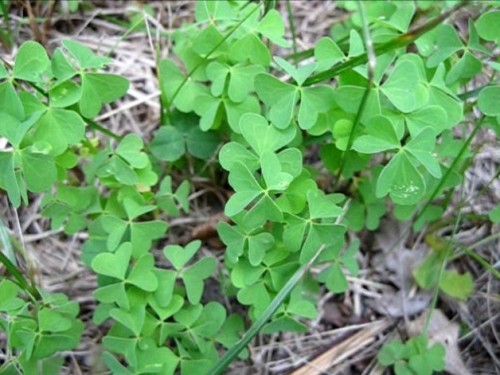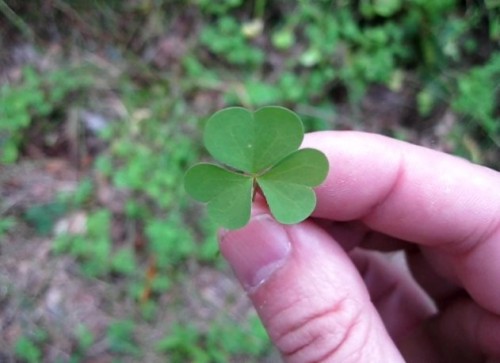Wild Foraging Series Wood Sorrel In Your Back Yard
Article from: August 14th, 2012
Wood Sorrel is a common weed that many of us around the US often mow down, pull out, poison, walk on and generally try to get rid of. It grows easily in your yard and garden. It is also just as happy growing in the forest.
Wood sorrel is easily identified by its three heart shaped leaves. It looks slightly like clover and is often sold as a Shamrock on St Patricks Day. The flowers bloom in Spring time and are normally yellow, but can also be found in pink, purple and white.
Below is a photo of wood sorrel growing at the edge of a cleared path in the forest.

Wood Sorrel, A Wild Edible Plant
Below is a close up view of a wood sorrel leaf stalk with its clearly distinguishable Shamrock like leaves.

How To Identify Wood Sorrel
Wood sorrel leaves may fold downward during rain or at night, as you can see a little in the first photo above. The photo was taken during a partly rainy day.
Wood sorrel, of the genus Oxalis, has been used by humans for thousands of years. Indians used wood sorrel for its medicinal properties. It also makes a nice addition to salads due to its slightly sour taste. Indians often used it on the trails as a refreshing thirst quencher.
Some medicinal uses are:
- Treatment of nausea
- Mouth sores
- Sore throat
- Ulcers
- Cancer
- Fever
- Urinary Infection
And it was also used in the treatment of scurvy in old times. This is good information for survival enthusiasts. Wood sorrel has a refreshing taste, as mentioned above. It makes a nice addition to your list of wild edible foods for survival and disaster readiness. Wood sorrel is one of the most easily identified and common of the wild edible foods covering most of North America and around the world.
Wood sorrel contains oxalic acid, which is considered slightly toxic in large quantities. But so do spinach, collard greens, beans and rhubarb, among others. Oxalic acid is known to limit the absorption of calcium, but is considered generally safe for people with a normal, balanced diet.
Note: The statements made on this page are not medicinal or doctor approved facts. This information is for educational purposes only. As with any herb, if you are taking medication, consult your doctor before trying it.
You can watch today's video here:
 Wood Sorrel - Wild Foraging Survival Foods
Wood Sorrel - Wild Foraging Survival Foods
While you are over there please subscribe to my YouTube channel and follow our daily videos as we strive to become self sufficient and off the grid on a budget.
Feel free to ask any questions or get help with your project on our
About the Author
| Troy Reid |




